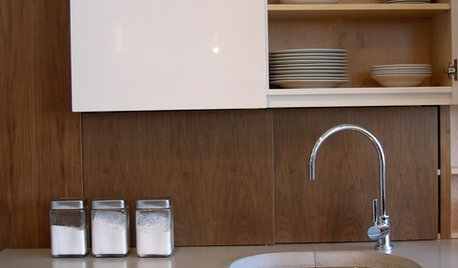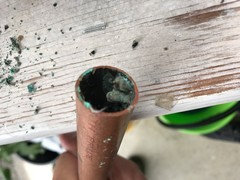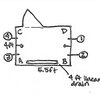Pin hole leaks in copper pipes
bnolan
16 years ago
Featured Answer
Sort by:Oldest
Comments (30)
ctbosox
16 years agolast modified: 9 years agodan_martyn
16 years agolast modified: 9 years agoRelated Discussions
Moldy Smelling Bathroom
Comments (2)My home is not as old but had pretty much the same moldy smelly problems from previous water damage. The PO's did lay down new linoleum and install a new vanity and mirror but that only served to cover up problems lying within the walls. The wonderful :( plastic tiles were popping off left and right and underneath them was mold and mildew. I bit the bullet and gutted it. I had a new tub w/shower installed, all new drywall put in along with insulation, tiled the shower walls and put in a new toilet and flooring. I even replaced all the wood trim and put in a new door. It turned out very nice (I think!), it took a month but would have been less, had not my tile guy decided to take a vacation in the middle of it. I kept the vanity and mirror. My total costs ran right up next to 3K. If you can do the tiling yourself, you can probably save some labor costs right there....See MoreBasement copper pipe water leak
Comments (5)If you know the exact location of the pin hole you can cheaply & easily make a permanent repair yourself and save the cost of a Plumbers service call. That appears to be a 1/2" copper pipe. Before you start, get a 1/2" copper pipe compression union. (A 5/8" copper tubing union is the same size). You will need a claw hammer to pull the pipe hanger, a tubing cutter to cut the pipe and either two channel lock pliers, two adjustable wrenches or an adjustble wrench & a pair of pliers. (You need one tool to hold the union steady while tigthening with the other). Begin by shutting the water off, then drain the system down until there is no water in that pipe. You should be abled to drain at a laundry sink or faucett in the basement or an outside hose bibb. When the water is drained cut the pipe and install the union where the leak is. Once tightened the union will servie as a code approved permanant repair. After the union is installed and tightened you can turn the water on again, then go to each faucett in the house and open the faucett to bleed off the air in the line until you get a full flow of water and go to the next faucett. After you bleed the air out the job is done. Total cost of repair about $5 for the union....See MorePinhole leak in Copper pipe
Comments (10)My first question would be are you certain that you actually have a leak? You were alerted to the problem by a small puddle of water on the floor under a vertical riser and you stated that you found a leak on the riser, but are you absolutely certain it is a leak or did you perhaps find a couple drops on the pipe near the bottom fitting and assume a leak? Far too often homeowners find droplets of water clinging to the underside of a horizontal copper line, or near the bottom fitting of a vertical riser and automatically assume the problem to be a pinhole when it is far more likely that the water droplets on the pipe are resulting from moisture in the atmosphere condensating on the exterior wall of a pipe, and in the case of a vertical riser that condensate may be occuring on the full length of the pipe, then flowing down the pipe in a light film that is almost invisible to the naked eye until it hits the ridge on the fitting at the bottom and forms a droplet before dripping off to the floor. If the problem is occuring as a result of condensation you can eliminate the problem by insultating the line, however if you are certain that you actually have a pinhole leak, the only real solution is to replace the line. Normally pinholes will show up first on horizontal lines and a true pinhole will manifest itself with a microfine mist spray. If you determine it is a pinhole and you opt to replace the line you may want to consider replacing it with CPVC or PEX....See MorePin hole in metal pipe
Comments (3)The section of pipe needs to be replaced. Is it a copper pipe? Maybe other areas of the pipe are also ready to leak. You need a plumber....See Morebnolan
16 years agolast modified: 9 years agovhehn
16 years agolast modified: 9 years agomagothyrivergirl
16 years agolast modified: 9 years agohomebound
16 years agolast modified: 9 years agozl700
16 years agolast modified: 9 years agolazypup
16 years agolast modified: 9 years agovhehn
16 years agolast modified: 9 years agoctbosox
16 years agolast modified: 9 years agolazypup
16 years agolast modified: 9 years agopatfro
16 years agolast modified: 9 years agolazypup
16 years agolast modified: 9 years agogypsy1969
15 years agolast modified: 9 years agobrickeyee
15 years agolast modified: 9 years agolazypup
15 years agolast modified: 9 years agopjb999
15 years agolast modified: 9 years agomatt_m
15 years agolast modified: 9 years agopjb999
15 years agolast modified: 9 years agolynda_2008
15 years agolast modified: 9 years agozl700
15 years agolast modified: 9 years agothull
15 years agolast modified: 9 years agobusboy
15 years agolast modified: 9 years agohherman_ms_cc_sunysb_edu
12 years agolast modified: 9 years agoBayview P&H Ltd.
7 years agoTpca
6 years agoUser
6 years agotiffanyhayes
5 years agoLaura Mac
5 years ago
Related Stories

KITCHEN APPLIANCESThe Many Ways to Get Creative With Kitchen Hoods
Distinctive hood designs — in reclaimed barn wood, zinc, copper and more — are transforming the look of kitchens
Full Story
KITCHEN WORKBOOK8 Kitchen Amenities You'll Really Wish You Had
Keep kitchen mayhem and muck to a minimum with these terrific organizers and other time-saving, mess-preventing features
Full Story
KITCHEN DESIGNKitchen Sinks: Fireclay Brims With Heavy-Duty Character
Cured at fiery temperatures, fireclay makes for farmhouse sinks that just say no to scratches and dents
Full Story
LIFEHouzz Call: Show Us Your Nutty Home Fixes
If you've masterminded a solution — silly or ingenious — to a home issue, we want to know
Full Story
FARM YOUR YARDHow to Build a Raised Bed for Your Veggies and Plants
Whether you’re farming your parking strip or beautifying your backyard, a planting box you make yourself can come in mighty handy
Full Story
CONTRACTOR TIPSYour Complete Guide to Building Permits
Learn about permit requirements, the submittal process, final inspection and more
Full Story
KITCHEN DESIGN20 Kitchen Must-Haves From Houzz Readers
We asked you to tell us your top kitchen amenities. See what popular kitchen features made the list
Full Story
GREAT HOME PROJECTSHow to Add a Skylight or Light Tube
New project for a new year: Increase daylight and maybe even your home’s energy efficiency by opening a room to the sky
Full Story
GREAT HOME PROJECTSHow to Switch to a Tankless Water Heater
New project for a new year: Swap your conventional heater for an energy-saving model — and don’t be fooled by misinformation
Full Story
GREAT HOME PROJECTSHow to Add an Outdoor Shower
New project for a new year: Experience bathing in a whole new light with a shower in the fresh air
Full Story





andy_c